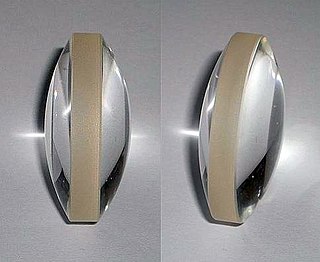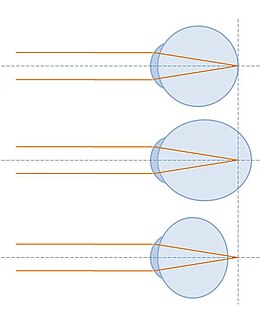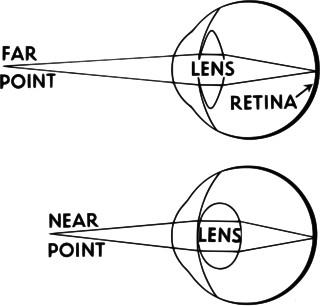
A lens is a transmissive optical device which focuses or disperses a light beam by means of refraction. A simple lens consists of a single piece of transparent material, while a compound lens consists of several simple lenses (elements), usually arranged along a common axis. Lenses are made from materials such as glass or plastic, and are ground and polished or molded to a desired shape. A lens can focus light to form an image, unlike a prism, which refracts light without focusing. Devices that similarly focus or disperse waves and radiation other than visible light are also called lenses, such as microwave lenses, electron lenses, acoustic lenses, or explosive lenses.

Optics is the branch of physics that studies the behaviour and properties of light, including its interactions with matter and the construction of instruments that use or detect it. Optics usually describes the behaviour of visible, ultraviolet, and infrared light. Because light is an electromagnetic wave, other forms of electromagnetic radiation such as X-rays, microwaves, and radio waves exhibit similar properties.

Myopia, also known as near-sightedness and short-sightedness, is an eye disorder where light focuses in front of, instead of on, the retina. This causes distant objects to appear blurry while close objects appear normal. Other symptoms may include headaches and eye strain. Severe near-sightedness is associated with an increased risk of retinal detachment, cataracts, and glaucoma.

In optics, a circle of confusion is an optical spot caused by a cone of light rays from a lens not coming to a perfect focus when imaging a point source. It is also known as disk of confusion, circle of indistinctness, blur circle, or blur spot.

The angle of view is the decisive variable for the visual perception of the size or projection of the size of an object.

Far-sightedness, also known as long-sightedness, hypermetropia, or hyperopia, is a condition of the eye where distant objects are seen clearly but near objects appear blurred. This blurred effect is due to incoming light being focused behind, instead of on, the retina wall due to insufficient accommodation by the lens. Minor hypermetropia in young patients is usually corrected by their accommodation, without any defects in vision. But, due to this accommodative effort for distant vision, people may complain of asthenopic symptoms during prolonged reading. Some hypermetropes can see clear at distance, but near vision may be blurred due to insufficient accommodation. For this reason, this defect is referred as far-sightedness. If the hypermetropia is high, there will be defective vision for both distance and near. People may also experience accommodative dysfunction, binocular dysfunction, amblyopia, and strabismus. Newborns are almost invariably hypermetropic, but it gradually decreases as the newborn gets older.

Presbyopia is physiological insufficiency of accommodation associated with the aging of the eye that results in progressively worsening ability to focus clearly on close objects. Also known as age-related farsightedness, it affects many adults over the age of 40. A common sign of presbyopia is difficulty reading small print which results in having to hold reading material farther away. Other symptoms associated can be headaches and eyestrain. Different people will have different degrees of problems. Other types of refractive errors may exist at the same time as presbyopia. This condition is similar to hypermetropia or far-sightedness which starts in childhood and exhibits similar symptoms of blur in the vision for close objects.

Magnification is the process of enlarging the apparent size, not physical size, of something. This enlargement is quantified by a calculated number also called "magnification". When this number is less than one, it refers to a reduction in size, sometimes called minification or de-magnification.

Visual acuity (VA) commonly refers to the clarity of vision, but technically rates an examinee's ability to recognize small details with precision. Visual acuity is dependent on optical and neural factors, i.e. (1) the sharpness of the retinal image within the eye, (2) the health and functioning of the retina, and (3) the sensitivity of the interpretative faculty of the brain. The most commonly referred visual acuity is the far acuity, which describes the examinee's ability to recognize small details at a far distance, and is relevant to people with myopia; However, for people with hyperopia, the near acuity is used instead to describe the examinee's ability to recognize small details at a near distance.
Anisometropia is when two eyes have unequal refractive power. Generally, a difference in power of two diopters or more is the accepted threshold to label the condition anisometropia.

Refractive error, also known as refraction error, is a problem with focusing light accurately on the retina due to the shape of the eye and or cornea. The most common types of refractive error are near-sightedness, far-sightedness, astigmatism, and presbyopia. Near-sightedness results in far away objects being blurry, far-sightedness and presbyopia result in close objects being blurry, and astigmatism causes objects to appear stretched out or blurry. Other symptoms may include double vision, headaches, and eye strain.

An eye examination is a series of tests performed to assess vision and ability to focus on and discern objects. It also includes other tests and examinations pertaining to the eyes. Eye examinations are primarily performed by an optometrist, ophthalmologist, or an orthoptist. Health care professionals often recommend that all people should have periodic and thorough eye examinations as part of routine primary care, especially since many eye diseases are asymptomatic.

Accommodation is the process by which the vertebrate eye changes optical power to maintain a clear image or focus on an object as its distance varies. In this, distances vary for individuals from the far point—the maximum distance from the eye for which a clear image of an object can be seen, to the near point—the minimum distance for a clear image. Accommodation usually acts like a reflex, including part of the accommodation-vergence reflex, but it can also be consciously controlled. Mammals, birds and reptiles vary their eyes' optical power by changing the form of the elastic lens using the ciliary body. Fish and amphibians vary the power by changing the distance between a rigid lens and the retina with muscles.

Visual angle is the angle a viewed object subtends at the eye, usually stated in degrees of arc. It also is called the object's angular size.

In optics, defocus is the aberration in which an image is simply out of focus. This aberration is familiar to anyone who has used a camera, videocamera, microscope, telescope, or binoculars. Optically, defocus refers to a translation of the focus along the optical axis away from the detection surface. In general, defocus reduces the sharpness and contrast of the image. What should be sharp, high-contrast edges in a scene become gradual transitions. Fine detail in the scene is blurred or even becomes invisible. Nearly all image-forming optical devices incorporate some form of focus adjustment to minimize defocus and maximize image quality.
In visual perception, the near point is the closest point at which an object can be placed and still form a focused image on the retina, within the eye's accommodation range. The other limit to the eye's accommodation range is the far point.

Emmetropia is the state of vision in which a faraway object at infinity is in sharp focus with the eye lens in a neutral or relaxed state. That condition of the normal eye is achieved when the refractive power of the cornea and eye lens and the axial length of the eye balance out, which focuses rays exactly on the retina, resulting in perfectly sharp distance vision. A human eye in a state of emmetropia requires no corrective lenses for distance; the vision scores well on a visual acuity test.

In photography, a close-up lens is a simple secondary lens used to enable macro photography without requiring a specialised primary lens. They work like reading glasses, allowing a primary lens to focus more closely. Bringing the focus closer allows the photographer more possibilities.
Vision of humans and other organisms depends on several organs such as the lens of the eye, and any vision correcting devices, which use optics to focus the image.

The unilens monocular is a simple refracting telescope for field use, designed by Robert Baden-Powell. Consisting of only one lens, it is the simplest of all telescopes, and while occupying very little space can still magnify a distant image up to about four times. The nature of its operation however does not accommodate to everyone's visual acuity, with only three out of four people able to use it.

















